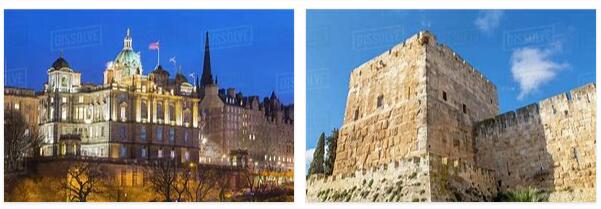World Heritage Sites (K) and World Natural Heritage (N)
- Danube Delta Biosphere Reserve (N; 1991)
- Villages and fortified churches in Transylvania (K; from 1993)
- Horezu Monastery (K; 1993)
- Moldavian monasteries (K; 1993)
- Dacian fortresses in the mountains of Orăştie (K; 1999)
- Maramureş wooden churches (K; 1999)
- Historic center of Sighișoara (K; 1999)
- Old beech forests and primeval beech forests in the Carpathian Mountains (N; 2017)
Fortifications of the Dacians (World Heritage)
The center of the Dacians was in the mountains of Orăştie, where their most important fortifications were located. They originated in the 1st century BC. BC and served to protect against Roman invasions until the Roman conquest at the beginning of the 2nd century. The six fortresses belonging to the world heritage document the connection between military and sacred architecture and prove the high cultural status of the Dacians.
Dacian fortifications: facts
| Official title: | Dacian fortifications in the mountains of Orastie (Broos) |
| Cultural monument: | Six fortifications (Sarmizegetusa, Costesti Cetatuie, Costesti-Blidaru, Luncani-Piatra Rosie, Banita and Capalna) built around Sarmizegetusa, capital of the Dacian kingdom under King Decebalus; Part of a bulwark of over 90 defensive structures, between 100 BC. Built against the advancing Romans; fortified settlements, stone defensive walls, wooden palisades, mighty earth walls (up to 14 m high) and a network of watchtowers; |
| Continent: | Europe |
| Country: | Romania |
| Location: | Hunedoara and Alba regions, Transylvania |
| Appointment: | 1999 |
| Meaning: | Unique and well-preserved example of late Iron Age defenses |
Dacian Fortifications: History
| 8th century BC Chr. | Settlement of the Getes and Dacians |
| 60-44 BC Chr. | Unification of the tribes into a Dacian empire by King Burebista |
| 1st century BC BC – 1st century AD | Construction of the fortifications |
| from 29 BC Chr. | Advance of the Romans across the Danube |
| 86-89 | Unsuccessful campaign of the Romans under Domitian against Dacia |
| 87-106 | Reign of King Decebalus |
| 101/102 and 105/106 | Successful campaigns of the Romans under Trajan against Dacia, partial destruction of the fortifications |
| 106 | Dacia Roman Province |
Maramureş Wooden Churches (World Heritage)
The wooden churches in the area between the Forest Carpathians and the Rodna Mountains have been built since the 14th century. The narrow clapboard houses of worship with their characteristic bell tower and folk paintings are evidence of high craftsmanship.
Maramureş wooden churches: facts
| Official title: | Maramureş wooden churches |
| Cultural monument: | Eight wooden churches in the Maramureş region, Transylvania; originated in the 17th and 18th centuries after the construction of larger stone buildings was banned by the kings of Hungary; Combining the influences of Byzantine architecture and European Gothic with local and folkloric elements; Churches in the Orthodox tradition with anteroom, nave and chancel; typical shingle-covered roofs and tall, slender bell towers on each western side; Interiors richly decorated with paintings and partly also with carvings |
| Continent: | Europe |
| Country: | Romania |
| Location: | Maramureş region, Transylvania |
| Appointment: | 1999 |
| Meaning: | Masterfully executed sacred architecture made of wood, developed under various cultural influences |
Maramureş Wooden Churches: History
| 1604 | Poienile Izei: “Church of Holy Providence” |
| 1643 | Budesti: »Church of St. Nicholas« (also »Church in the Valley«) |
| 1663 | Rogoz: “Church of the Holy Archangel” |
| 1720 | Barsana: “Church of the Entry of the Virgin into the Temple” |
| around 1750 | Leud: “Church of the Holy Virgin” |
| 1767 | Surdesti: “Church of the Holy Archangels” (highest tower with 54 m height) |
| 1770 | Desesti: “Church of St. Paraskeva” |
| 1796-98 | Plopis: “Church of the Holy Archangels” |
Old town of Sighișoara (World Heritage)
The small town founded by the Transylvanian Saxons at the end of the 12th century developed into a flourishing trading center in Transylvania in the Middle Ages. The old town consists of very well-preserved town houses from the 16th and 17th centuries and is considered one of the most beautiful cities in Romania. The city’s landmark is the mighty 14th century clock tower.
Sighișoara Old Town: Facts
| Official title: | Historic center of Sighișoara (Schäßburg) |
| Cultural monument: | Fortified castle hill (“upper town”), surrounded by a 930 m long castle wall with originally 14 mighty defensive towers (erected in the 14th – 16th centuries), nine of which have survived; Financing, maintenance and manning of the defense towers by the city guilds; Main gate with hour tower, built in the 14th century on the foundations of a Roman fort (64 m high, four corner towers; Baroque clock tower from 1648, rebuilt in 1677); Monastery church (first mentioned in 1298, baptismal font in 1440, baroque altar in 1680); wood-roofed »student stairs« (1642); Mountain school (early 17th century); Gothic-baroque mountain church (14th / 15th century, then rebuilt several times, wall paintings) |
| Continent: | Europe |
| Country: | Romania |
| Location: | Sighișoara, Mures County |
| Appointment: | 1999 |
| Meaning: | Well-preserved, medieval city of great beauty; cultural testimony of the Transylvanian Saxons |
Old town of Sighișoara: history
| 2nd / 3rd Century | Roman army camp |
| 12th century | Founding of the city by German immigrants |
| 1367 | Granting city rights, own jurisdiction |
| 14-16. Century | The city’s heyday, an important center of handicrafts and trade |
| 16.-18. Century | Multiple sieges (Turkish rule, Kuruc Wars) |
| 1544 | The population converts to Protestantism |
| 1603/1709 | Plague epidemic |
| 1676 | Destruction of the hour tower as well as a large part of the castle and the city by a major fire |
